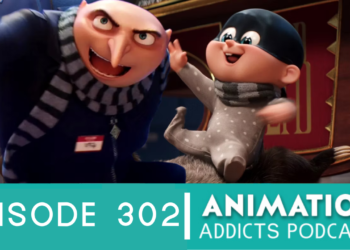The prospect of merging Star Wars with Japanese animation is nothing short of brilliant. Anime is bigger than it’s ever been in the mainstream market, and while Disney+ has an abundance of animated classics under its umbrella, an anime selection is all but nonexistent. Star Wars: Visions, an anthology of Star Wars short films produced by Japanese animation studios, looks to be Disney’s first attempt at rectifying this issue.
“The Duel”
Developed by Kamikazi Douga in the style of a classic chanbara, “The Duel” tells the story of a wandering swordsman who must defend a village from the wrath of invaders. The highlight of this episode are the two lead characters, Ronin and especially the Bandit Leader. Not only are their character designs rich with intrigue and history, but the voice-acting beautifully sells their roles as the quiet hero and arrogant villain, respectively. Unfortunately, the art style was a touch too graphic, making it difficult to see some of the onscreen happenings. This episode is also light on story, with the bulk of the runtime being pure action, which got a little boring after a while.
“Tatooine Rhapsody”

Relative to its predecessor, Studio Colorido’s “Tatooine Rhapsody” is a fun tale about friendship, told through the eyes of a starry-eyed band group. There’s much more emphasis on character and relationships this time around, making it easier to care about the action onscreen. There’s also some fun surprises that organically tie this story into the larger Star Wars universe that we all know. This is a fun entry.
“The Twins”
The animation on display in Studio Trigger’s “The Twins” is utterly gorgeous. On the whole, however, the episode is largely “style over substance”. Most of the exposition is dedicated to the titular twins’ mission to bring order to the galaxy, and thus we’re left knowing little about the twins as actual characters or their dynamic with one another. That unfortunately made the episode a drag to get through. It didn’t help that the English voice acting was laughably campy.
“The Village Bride”

From Kinema Citrus, “The Village Bride” tells the story of a remote village under the threat of a sadistic warlord. This short is a beautifully crafted piece of art that focuses less on action and more on world-building and character development. The crew at Kinema Citrus expertly utilized their minimal runtime to get us acquainted with the titular village, introduce the conflict, make us understand the protagonists and their motivations, and deliver a satisfying resolution. It’s phenomenal, and my personal favorite of this collection. Special mention goes out to the music score and the English voice acting for elevating this material with their respective work.
“The Ninth Jedi”
Production I.G’s entry presents a classic hero’s journey with a likable protagonist and an riveting story to boot. That would arguably make “The Ninth Jedi” the most traditional Star Wars story of the lot, but that’s no slight. Sometimes it’s nice to watch a good, old-fashioned adventure.
“T0-B1”

“T0-B1” is easily the most unique episode in terms of art style. The character designs are simplistic and bubbly, harkening back to animations of old such as Astro Boy and Walt Disney’s Pinocchio. At the start, the story is similarly whimsical in tone, telling the tale of a humanoid droid with dreams of becoming a Jedi. Both the artistic and narrative directions of “T0-B1” took me by surprise in the best ways, making it one of the highlights of the series.
“The Elder”
Studio Trigger’s “The Elder” is largely unremarkable. The entire first half of the episode serves only as buildup for the climax, which is one of the most exciting action scenes of the entire series to be fair. This is thanks largely to the episode’s antagonist, whose design and animation are appropriately chilling. Outside of the villain, however, there’s nothing here to write home about. There’s an attempt to establish a bond between our two protagonists, but the stiff delivery on the actors’ end makes such a connection difficult to buy into.
“Lop and Ochō”

I appreciate much of Geno Studio’s “Lop and Ochō”. At its core, it’s a tragic tale about a family torn apart by varying ideals in relation to the Empire. It’s a fascinating take on the Empire’s effects on the galaxy, focusing more on interpersonal rifts rather than the standard warfare we see in most Star Wars media. What diminishes some of “Lop and Ochō”’s appeal is Lop herself, who isn’t terribly interesting as a character. I was also disappointed by the lack of world-building for the city in which “Lop and Ochō” takes place, but that’s more of a nitpick.
“Akakiri”
“Akakiri” by Science SARU is the final episode of the batch, and yet I can barely remember any of it. There’s an entertaining comic relief duo that garnered a few chuckles, but beyond that, there is nothing of note here.
Verdict
By nature of being an anthology series, Star Wars: Visions is a mixed bag in terms of both style and quality—there are high highs, and lows lows here. While I would recommend Visions to diehard Star Wars and anime fans, I can’t say the same for the casual Disney+ subscriber. All this does little to diminish the genius that is this show’s very conception, however. As a fan of both Disney and Japanese animation, it’s always wonderful to see these two entities collide to some extent. One can only hope that similar collaborations are on the horizon with both Star Wars and other Disney-owned IPs.
Have you seen Star Wars: Visions yet? Which episode was your favorite?
Edited by: K. Conley







![[LOOKING BACK] ‘The Fox and the Hound’ at 40](https://www.rotoscopers.com/wp-content/uploads/2021/09/fox-and-the-hound-75x75.jpg)